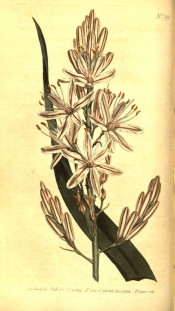Asphodelus aestivus Brot.
Stout, erect stem to 90cm, the leaves flat, broad, linear to linear-lanceolate, to 3cm wide, leathery, thick, long, pointed, the flowers white with a reddish middle stripe in densely-flowered panicles, the branches to 30cm long, in spring. [RHSD, Hortus].
Horticultural & Botanical History
‘Native of the South of Europe. Immense tracts of land in Apulia are covered with it, and it affords good nourishment to the sheep. Cultivated in 1596, by Gerrard. Hardy. It does not increase very fast by roots, nor should it be often transplanted, for that will weaken it, so that the flower stems will not rise so tall, nor produce so many flowers, as when left undisturbed for some years; therefore the best way is to propagate it by seeds.’ [BM t.799/1804].
‘Asphodelus verus ramosus albus: An elegant garden flower, a native of Italy, and preserved with us more for its beauty than its use, though sometimes taken as a medicine.’ [Hill p.18].
History at Camden Park
A handwritten note in an 1850 catalogue is the only reference [MP A2947A]. Certainly grown in the gardens at this time.
Notes
Asphodelus aestivus Brigant. (1816) = Asphodeline liburnica Rchb. This is also a possibility. [RHSD, BM t.2626/1826].
Published Jan 10, 2010 - 03:25 PM | Last updated Jan 10, 2010 - 03:32 PM
| Family | Asphodelaceae |
|---|---|
| Category | |
| Region of origin | Southern Europe to Asia and north Africa |
| Synonyms |
|
| Common Name | |
| Name in the Camden Park Record | Asphodelus aestivus |
| Confidence level | medium |
